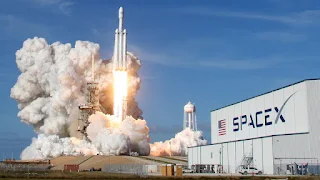The big new SpaceX rocket took off on Tuesday on its first test flight, carrying a red sports car that points to an endless journey through space beyond Mars.
 |
| Powerful Space X Rocket Takes Off with Sports Car on Board |
The Falcon Heavy rocket started from the same launch pad used by NASA almost 50 years ago to send men to the Moon. With the takeoff, the Heavy became the most powerful rocket in use today, doubling the takeoff hit of its closest competitor.
The three thrusters and 27 engines roared as they ignited at the Kennedy Space Center, while thousands of people gathered on the beaches, bridges and roads in the vicinity to see how the rocket was launched, delayed more than two hours by the strong wind.
Two of the propellers were recycled and returned minutes later to land, landing simultaneously at Cape Canaveral; the third, failed to descend to an ocean platform about 483 kilometers from the coast and crashed into the sea.
The chief executive of SpaceX, Elon Musk, owns the Tesla Roadster, which was fired into a solar orbit that will reach Mars. As head of the electric car maker Tesla, he combined his passions to add a dramatic twist to the long-awaited inaugural flight of the Heavy. The typical counterweight to launching a rocket are concrete or steel slabs, or experiments.
On the eve of the flight, Musk told reporters that the company had done everything possible to maximize success and was at peace with what happened: success, "a big bang" or some other calamity. The longer the flight, he pointed out, the more the company of the highly instrumented rocket would learn.
Musk has a lot of experience in rocket accidents, from his original Falcon 1 test flights to his Falcon 9 tracking, one of which exploded on a nearby platform during a power-up test in 2016. The Falcon Heavy is a combination of three Falcon 9, the rocket that the company uses to send supplies to the International Space Station and lift satellites. Spacex is reusing first stage boosters to save on launch costs.
The Heavy is intended for massive satellites, such as those used by the US military. and the major league communications companies. Even before the test flight, customers registered.
Given the high stakes and the great drama, Tuesday's launch attracted large crowds that had not been seen since the last NASA space flight seven years ago. While the ferries had more takeoff muscle than the Heavy, the leaders of all times, both in size and strength, were NASA's Saturn V rockets, which first took the astronauts to the moon in 1968.
Not to mention the lunar buggies of the Apollo, the Roadster is the first car to "take off" directly from the planet.
At the wheel of the convertible is "Starman" a SpaceX mannequin, with a black and white space suit, and on the soundtrack there is another nod to David Bowie: his 1969 song, before the Apollo 11 "Space Oddity '', with the memorable memorable phrase "Ground Control to Major Tom". SpaceX expects live images of the car from the on-board cameras, once the protective cabin is released and the vehicle is completely exposed when leaving space.
The car faces considerable speed buffers before settling in its planned orbit around the sun, an oval circle that extends from Earth's orbit at one end to the orbit of Mars at the other.
First, the Roadster needed to survive the takeoff, a great feat for a rocket fresh from the factory. Then he has to endure a cosmic bombardment in his several hours of cruising through the highly charged Van Allen radiation belts that surround the Earth. Finally, a propeller has to shoot to put the car in the correct orbital course.
If all this happens, the Roadster will arrive in the vicinity of Mars in six months, Musk said. The car could be traveling between Earth and Mars for a billion years, according to the billionaire.
Musk acknowledged that the Roadster could "get close enough" to Mars during its epic journey, with only a remote possibility of crashing into the red planet.
Win or lose, the Heavy is already shaking the launch market. Its tag price is $ 90 million, less than one tenth of the estimated cost of the NASA rocket megacohete in development for expeditions to the Moon and Mars.
SpaceX has decided not to fly passengers in the Heavy, Musk told reporters on Monday, and instead accelerate the development of an even larger rocket to accommodate crews in deep space. Its ultimate goal is to establish a city on Mars.
